Mount Selinda, at an altitude of 1,100 metres, is a village and mission station in the province of Manicaland in the eastern mountains of Zimbabwe. Located close to the Mozambique border, it lies in an area of outstanding natural beauty. Mount Selinda sits on an east-facing slope, on the very edge of the Chirinda Forest Botanical Reserve – the southernmost tropical rainforest in Africa.
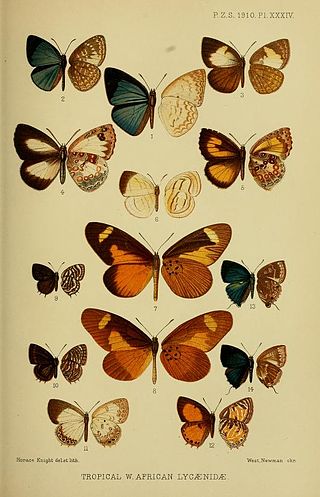
Mimacraea is a genus of butterflies in the family Lycaenidae. The species of this genus are endemic to the Afrotropical realm. As the name suggests, Mimacraea species are mimics of species in the genus Acraea and related genera.
Mimacraea abriana is a butterfly in the family Lycaenidae. It is found in the Republic of the Congo, the Democratic Republic of the Congo and the Central African Republic.

Mimacraea charmian, the elongata acraea mimic, is a butterfly in the family Lycaenidae. It is found in Nigeria, Cameroon and the western part of the Democratic Republic of the Congo. The habitat consists of forests.
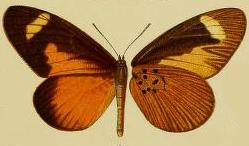
Mimacraea landbecki is a butterfly in the family Lycaenidae first described by Hamilton Herbert Druce in 1910. It is found in Cameroon, the Republic of the Congo, the Democratic Republic of the Congo, Uganda and Tanzania. The habitat consists of forests.
Mimacraea costleyi is a butterfly in the family Lycaenidae first described by Hamilton Herbert Druce in 1912. It is found in Malawi.
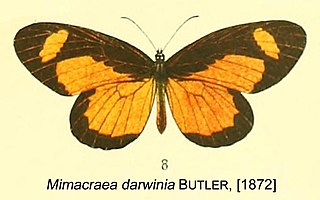
Mimacraea darwinia, the common acraea mimic, is a butterfly in the family Lycaenidae. It is found in Sierra Leone, Liberia, Ivory Coast, Ghana, Nigeria, Cameroon, Gabon and possibly the western part of the Democratic Republic of the Congo. The habitat consists of forests.

Mimacraea apicalis, the central acraea mimic, is a butterfly in the family Lycaenidae. It is found in Nigeria, Cameroon, Gabon and the Republic of the Congo.
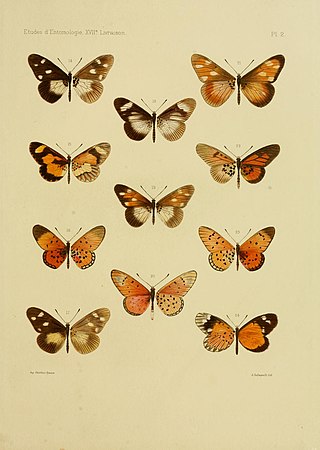
Mimacraea gelinia is a butterfly in the family Lycaenidae. It is found in Tanzania. The habitat consists of forests.

Mimacraea krausei, the Krause's acraea mimic, is a butterfly in the family Lycaenidae. It is found in Cameroon, the Republic of the Congo, the Democratic Republic of the Congo, Sudan, Uganda, Kenya and Tanzania. The habitat consists of forests.
Mimacraea maesseni, the Maessen's acraea mimic, is a butterfly in the family Lycaenidae. It is found in Ghana, Togo and southern Nigeria. The habitat consists of forests.
Mimacraea marginata is a butterfly in the family Lycaenidae. It is found in Tanzania.
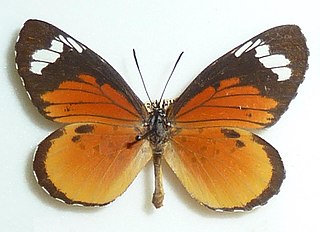
Mimacraea marshalli, Marshall's acraea mimic, is a butterfly in the family Lycaenidae. It is found in Uganda, Kenya, Tanzania, Malawi, the Democratic Republic of the Congo, Zambia and Zimbabwe. The habitat consists of Brachystegia woodland in hilly country at altitudes ranging from 1,200 to 1,700 metres, as well as open woodland.

Mimacraea neavei is a butterfly in the family Lycaenidae. It is found in Cameroon.
Mimacraea neurata, the alciope acraea mimic, is a butterfly in the family Lycaenidae. It is found in Guinea, Sierra Leone, Liberia, Ivory Coast, Ghana, Togo, Nigeria, the Republic of the Congo and the Democratic Republic of the Congo. The habitat consists of forests.

Mimacraea fulvaria is a butterfly in the family Lycaenidae. It is found in the Republic of the Congo, the Democratic Republic of the Congo, Uganda and Tanzania. The habitat consists of dense forests.

Mimacraea paragora is a butterfly in the family Lycaenidae. It is found in Cameroon and the Democratic Republic of the Congo.
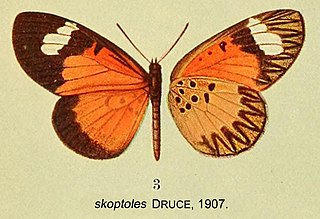
Mimacraea skoptoles is a butterfly in the family Lycaenidae first described by Hamilton Herbert Druce in 1907. It is found in Tanzania, the Democratic Republic of the Congo (Katanga) and Zambia. The habitat consists of riverine forests.

Mimacraea telloides is a butterfly in the family Lycaenidae. It is found in Cameroon and the Democratic Republic of the Congo.

The 950 hectares Chirinda Forest Botanical Reserve is situated on the slopes of Mount Selinda, 30 km south of Chipinge, in the Chipinge Highlands of Manicaland, Zimbabwe, and is administered by the Forestry Commission. The reserve is situated at between 900 and 1,200 m in altitude, and receives some 1,370 mm (54 in) to 1,466 mm (57.7 in) of annual rainfall. 606 hectares of its higher levels, above 1,076 m (3,530 ft), is covered by moist evergreen forest, specifically Zanzibar-Inhambane transitional rain forest, of which it represents the southernmost occurrence. The headwaters of three streams, namely the Zona, Chinyika and Musangazi, drain the two broad highlands which it encloses. The boundaries of the reserve are not strictly enforced, so that cattle grazing and plant harvesting are ongoing. The reserve is surrounded by communal settlements, commercial timber plantations and small-scale commercial farming units. The naturalist Charles Swynnerton was appointed manager of the nearby Gungunyana farm in 1900, and a number of plant, bird and insect names commemorate his collecting activities of the next two decades. Chirinda means "lookout" or "vantage point" in the chiNdau language, or perhaps "place of refuge".












